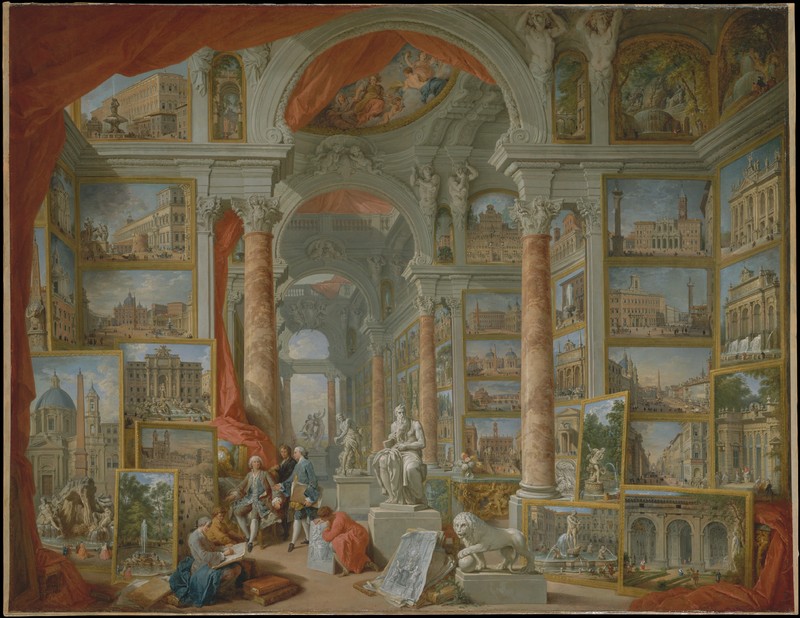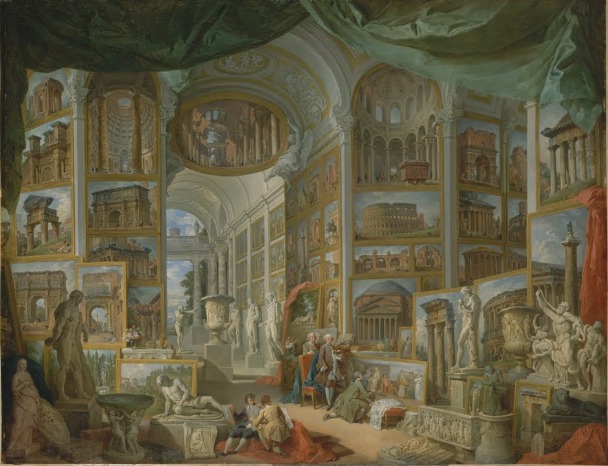Multiple Views of Rome

Giovanni Paolo Panini, Modern Rome, 1757, oil on canvas (Metropolitan Museum of Art)

Giovanni Paolo Panini, Ancient Rome, 1757, oil on canvas (Metropolitan Museum of Art)
Panini was not only renowned for his single views, he also experimented with multiple views of Rome in a single canvas. On the commission of the Duc de Choiseul, Panini was commissioned to create a work specifically intended to remind the Duke of the city, hence the creation of the large-scale oil on canvases of Ancient and Modern Rome. Together these works constitute a celebration of the reinvigorated interest in classicism at the time. Panini’s Ancient Rome assembles the founding ancient monuments of Rome, inviting the viewer to engage directly with the source of classical ideals themselves. Modern Rome creates a bridge with classical ideals by celebrating monuments and images imported from the high Renaissance and Baroque periods when classicism enjoyed a revival of praise and emulation. Art historian Ferdinando Arisi characterizes Modern Rome as a kind of personal exhibition by Panini of his paintings of vedute reali.[1] The painting discussed herein is one of three versions of Modern Rome, currently belonging to the collection at the Metropolitan Museum. The monumental oil on canvas dates back to 1757, and measures 172.1 cm x 233 cm. The painting depicts six gentlemen in an expansive space of towering arched ceilings held up by marble columns and adorned by statuettes and classical motifs. Panini’s paintings of views of modern Rome cover the walls of this cavernous space from floor to ceiling. The figures portrayed are surrounded and immersed in framed paintings of notable Roman landmarks of the Renaissance and Baroque periods, surely hallmarks in every Grand Tourist’s guidebook. What is more, a contemporary connoisseur of Panini would easily recognize some of the single vedute completed earlier in his career. Modern Rome pays tribute not only to the beauty and glory of Rome, but to the Grand Tour itself; and thus, much like its counterpart, Ancient Rome, the painting pays tribute to the idea of tribute.
Modern Rome is a pure celebration of the rebirth of classicism in the Renaissance, featuring renowned artists and works, such as the sculpture by Michelangelo of Moses from the tomb of Julius II, and Bernini’s David and Apollo and Daphne.[2] The space is constructed in such a way that within this fictitious environment, the figures and some of the paintings placed on the floor all coincide in the center of the composition around Michelangelo’s statue of Moses. However, much like Panini’s Interior of St. Peter’s, the depth of the painting goes far beyond the foreground and extends into the archway, which is also decorated to the ceiling with Panini’s vedute and other statues. The figures present in the bottom center of the composition are separated into two groups of three, the furthest cluster from the foreground including the Duc de Choiseul, who is seated, and two men beside him; the gentleman in blue, seen in profile and holding a sketch book is thought to be a self-portrait of the artist.[3] In front of them, art students work to complete a drawing exercise. In addition to reflecting the 18th century fascination with these historical periods of what was considered enlightened artistic achievement, the Ancient and Modern Rome paintings again pay testament to Panini’s skillful attention to detail and mastery over architecture. Each veduta is rendered as if it were a stand-alone painting. The viewer has a feeling that simply by extending a hand, one could take a vedute from its wall for a keepsake. Adjectives such as grandiose, monumental, vibrant, and classical are all applicable to this work, as not one suffices to encompass all of its attributes.
[1] Arisi, Gian Paolo Panini E I Fasti Della Roma del’700, 174.
[2] Bowron et al., Art in Rome in the Eighteenth Century, 427.
[3] Ibid.